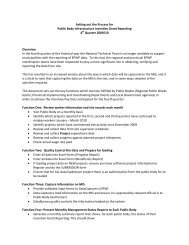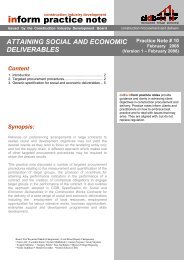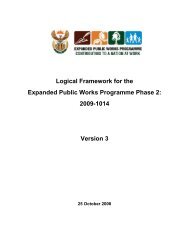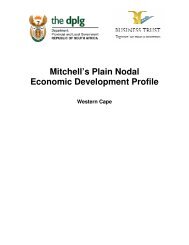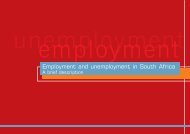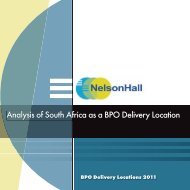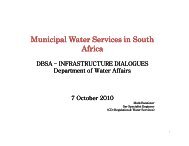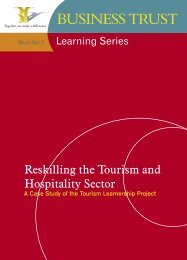Evaluation of the Monyetla Work Readiness ... - Business Trust
Evaluation of the Monyetla Work Readiness ... - Business Trust
Evaluation of the Monyetla Work Readiness ... - Business Trust
Create successful ePaper yourself
Turn your PDF publications into a flip-book with our unique Google optimized e-Paper software.
CONTENTSDEFINITIONS...............................................................................................................................4ACRONYMS..................................................................................................................................5EXECUTIVE SUMMARY.............................................................................................................61 BACKGROUND TO THE CASE STUDY......................................................................101.1 Introduction and Context....................................................................................................................101.2 Opportunities in <strong>the</strong> South African BPO&O Sector.....................................................................101.3 Challenges................................................................................................................................................111.4 The BPO&O Sector Support Programme (SSP).............................................................................111.5 A Skills Development Strategy for <strong>the</strong> BPO&O Sector ...............................................................121.6 This Report..............................................................................................................................................122 THE MONYETLA WORK READINESS PROGRAMME .............................................132.1 Introduction and Background .............................................................................................................132.2 The Case for a <strong>Work</strong> <strong>Readiness</strong> Programme.................................................................................132.2.1 Responding to Increased Demand for <strong>Work</strong> Ready Entrants 132.2.2 Meeting <strong>the</strong> Expectations <strong>of</strong> Investors 132.2.3 Meeting <strong>the</strong> Challenges <strong>of</strong> <strong>the</strong> Previously Disadvantaged and <strong>the</strong> Disabled 142.2.4 Meeting <strong>the</strong> Needs <strong>of</strong> <strong>the</strong> Unemployed 142.3 The Role <strong>of</strong> <strong>the</strong> <strong>Work</strong> <strong>Readiness</strong> Programme ...............................................................................152.4 The Scope <strong>of</strong> <strong>the</strong> Programme.............................................................................................................152.5 Programme Beneficiaries (Learners) .................................................................................................162.6 The Curriculum......................................................................................................................................162.7 Services SETA Involvement .................................................................................................................172.8 Project Governance and Management..............................................................................................172.9 A Description <strong>of</strong> <strong>the</strong> Model ................................................................................................................182.10 Evaluating <strong>the</strong> Model .............................................................................................................................192.11 The Funding Model................................................................................................................................192.11.1 Factors that could Impact on Training Costs <strong>of</strong> <strong>Monyetla</strong> Programme for <strong>the</strong> Period2006-2010 202.11.2 Sources <strong>of</strong> Funding 202.11.3 Funding Approach 203 APPROACH TO THE CASE STUDY.............................................................................233.1 Introduction ............................................................................................................................................233.2 Research Tools.......................................................................................................................................233.3 Data Ga<strong>the</strong>ring .......................................................................................................................................244 FINDINGS ...........................................................................................................................254.1 Project Management <strong>Evaluation</strong> .........................................................................................................254.1.1 Project Process <strong>Evaluation</strong> 254.1.2 Additional Comments on <strong>the</strong> Findings 294.2 Structure <strong>of</strong> Consortia .........................................................................................................................304.2.1 Institutional Arrangements 304.2.2 Consortium Leadership 314.2.3 Provincial Spread 354.3 Training <strong>of</strong> Unemployed Learners .....................................................................................................354.3.1 Recruitment Process and Methodology 354.3.2 Involvement <strong>of</strong> Employers in <strong>the</strong> Selection Process 364.3.3 The Quality Management System (QMS) 364.3.4 Accreditation and Quality <strong>of</strong> Training 374.3.5 Quality <strong>of</strong> Learners 374.3.6 Completions 394.3.7 Placement Rates 424.3.8 Learner Demographics 434.3.9 Supervisor and Management Training 432



